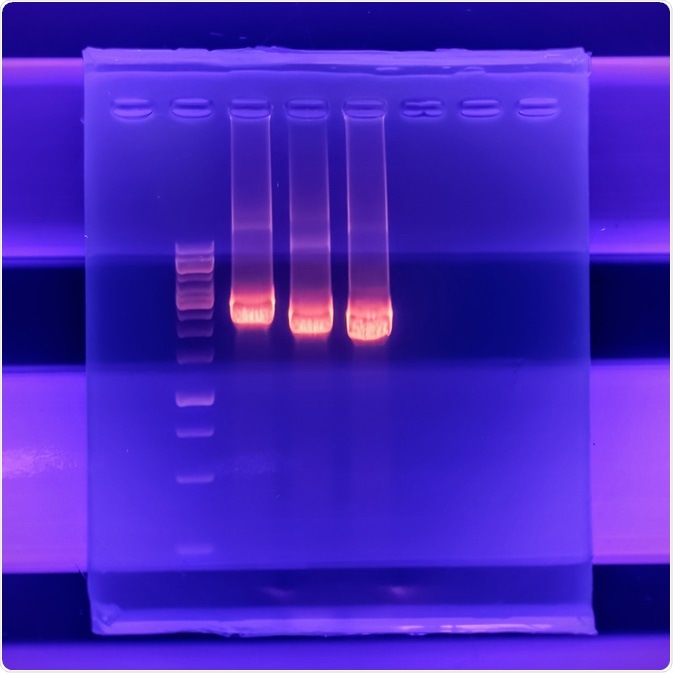How Is Gel Electrophoresis Used In Forensics
Electrophoresis as a Tool in Forensics
The ability to separate proteins and other biological components mean that electrophoresis is pop in the field of forensics, peculiarly in the analysis of unknown samples.

Electrophoresis. Paradigm Credit: Martinek Jan/Shutterstock.com
What are the basic principles of electrophoresis?
In electrophoresis, the substance that has to be separated is made to travel across a gel with a specific pore size using an electrical field. Also, one terminate of the gel has a positive charge, while the other stop has a negative accuse. The move of the substance is based on its charge and mass.
Equally unlike components in a substance may accept variable masses and charge, they will motility differentially. For example, a larger strand of DNA will travel a shorter distance when compared to a smaller strand. Similarly, a component that is positively charged will move faster towards the negative end of the gel, compared to a component that has a negative charge. Thus, electrophoresis tin can exist used to split unknown compounds in a substance.
Electrophoresis for DNA testing
Dna is a negatively charged molecule due to the presence of a phosphate group. Thus, when an electric field is applied, Deoxyribonucleic acid volition move towards the positive anode. Equally described before, the rate of this movement volition exist based on its charge and mass.
When moving in a liquid the speed of migration volition be much faster, making information technology increasingly difficult to separate the differential speeds of dissimilar DNA molecules. The employ of a gel slows this procedure down, making it easier to resolve DNA molecules moving at different speeds. Agarose or polyacrylamide gel is the most commonly used reagents in gel electrophoresis.
Dna fingerprinting
Dna differences between two people can be found with the help of short tandem repeats (STRs), which are a detail type of echo that is variable and can be measured. During the forensic assay, around 1 nanogram of Deoxyribonucleic acid is first extracted from the sample.
Using a principle called PCR or polymerase chain reaction, the sequence is amplified several times. There are 13 cadre STRs, the size of which varies betwixt 100–300 bases. For the forensic analysis, all thirteen STRs are examined between the two samples to assess the similarity betwixt them.
Using electrophoresis to split up proteins in blood
Electrophoresis can be used to clarify proteins, including those establish in human claret. Different DNA or RNA, proteins may not exist charged. Hence, the sample is frequently treated with a detergent called sodium dodecyl sulfate. Mixing blood with this detergent causes proteins to unravel and too imparts a negative charge to them.
This makes the poly peptide migrate towards the positive end (anode) in electrophoresis. The greater the charge, the further the poly peptide will travel. This can be used to measure out the presence of specific proteins in blood or the presence of abnormal substances or even the presence of diseases. Thus, this application may be useful in forensics to detect any injected substances in the blood or the presence of diseases in suspects.
Capillary electrophoresis
This method is also known as loftier-performance capillary electrophoresis and tin can exist used to separate different kinds of molecules, including inorganic molecules and biopolymers. This method is highly efficient, fast (tin can deliver results in less than 30 minutes), requires tens of ml of buffer per day, has a loftier resolution and is simple.
The components of capillary electrophoresis include an injection organisation, capillary and high voltage source, electrode, and a detector. This method works for charged inorganic molecules. The inorganic molecules volition motion based on their accuse towards the oppositely charged end. This method has advantages over other methods, such as High-Operation Liquid Chromatography (HPLC).
HPLC has more than complex instrumentation, which makes it hard to handle and operate. All the same, it also has a wider variety of column lengths, while capillary electrophoresis is restricted to thin capillaries.
Further Reading
- All Forensics Content
- Epigenetics and Forensics
- Chromatography in Forensic Science
- Overcoming Dna Degradation in Forensic Science
- Reducing PCR Inhibition in Forensic Science
Concluding Updated: April 8, 2021
Citations
Please use one of the following formats to cite this article in your essay, newspaper or report:
-
APA
P, Surat. (2021, April 08). Electrophoresis as a Tool in Forensics. News-Medical. Retrieved on September 22, 2022 from https://www.news-medical.net/life-sciences/Electrophoresis-as-a-Tool-in-Forensics.aspx.
-
MLA
P, Surat. "Electrophoresis equally a Tool in Forensics". News-Medical. 22 September 2022. <https://www.news-medical.net/life-sciences/Electrophoresis-as-a-Tool-in-Forensics.aspx>.
-
Chicago
P, Surat. "Electrophoresis equally a Tool in Forensics". News-Medical. https://world wide web.news-medical.net/life-sciences/Electrophoresis-every bit-a-Tool-in-Forensics.aspx. (accessed September 22, 2022).
-
Harvard
P, Surat. 2021. Electrophoresis equally a Tool in Forensics. News-Medical, viewed 22 September 2022, https://www.news-medical.net/life-sciences/Electrophoresis-as-a-Tool-in-Forensics.aspx.
How Is Gel Electrophoresis Used In Forensics,
Source: https://www.news-medical.net/life-sciences/Electrophoresis-as-a-Tool-in-Forensics.aspx
Posted by: samonsatrom1955.blogspot.com



0 Response to "How Is Gel Electrophoresis Used In Forensics"
Post a Comment